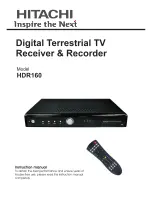
CAUTION: Ensure that any speaker that is to be
used near a TV or monitor is of the magnetically
shielded type (see loudspeaker’s instruction manual).
It is not normally possible to modify an unshielded
speaker to work very close to a TV or monitor.
WHY HAVE A SUB-WOOFER?
Many film soundtracks rely heavily on very low
frequency sound effects which are difficult for normal
hi-fi speakers to reproduce. To faithfully reproduce
these low frequencies you can use a specially
designed low frequency loudspeaker with its own
built-in amplifier. Because it is difficult to hear which
direction very low frequencies are coming from, you
only normally need one sub-woofer and this can be
placed virtually anywhere in the room. The SUB
WOOFER output of the AV 711 is designed
specifically to drive a sub-woofer system.
SPEAKER PHASE
In a home theatre system it is important that the
three front speakers are all in phase compared to
each other. Incorrect phase will produce a poor
stereo image and an apparent lack of bass. If you are
using speakers all from one manufacturer and power
amplifiers all from one manufacturer then to ensure
correct phasing of the system, just make sure that all
the red + connectors on the power amplifier speaker
outputs are connected to the red + connector on
the loudspeaker.
If you are using a mix of amplifiers or speakers
from different manufacturers, or using amplifiers in
‘bridge’ mode, then it is possible that the phase can
be internally reversed in the some of the amplifiers
or speakers, so you must check for correct phase
by listening.
To check phase by listening, set the AV 711 to
DOLBY PRO LOGIC and MUTE OFF and select a
FM radio station. This will give you the same sound
on all three front speakers. Disconnect the surround
speakers and the right front speaker. A stable sound
image should be heard as though it comes from a
single point between the centre and left front
speakers. If the signal sounds diffuse and not as
though it is coming from a single point in space,
reverse the connections to the center loudspeaker.
The signal should now appear to come from a single
point between the left and centre speakers.
Reconnect the right front speaker and disconnect
the left front speaker and repeat the procedure for the
right and center front speakers, changing the connec-
tion only on the right front speaker if the phase needs
correction.
Surrounds will normally be in phase with each other
if they have been correctly connected.
There is no absolute rule regarding the relative
phase between the front speakers and the surround
speaker pair or the Sub-Woofer (if used). Connecting
these using the red + connector from the amplifier to
the red + connector on the speakers should produce
correct results. But in some rooms reversing the con-
nections may produce a noticeable increase in bass
response or an improvement in overall stereo
imagery, so you may wish to experiment with revers-
ing the connections on both the surrounds or revers-
ing the connections to the sub-woofer.
SYSTEM EXAMPLES
The AV 711 can be used at the heart of a broad
range of surround sound systems. Here are two
possible systems configurations; one basic and one
advanced.
A SIMPLE SET-UP USING THE AV 711
This system uses the AV 711 with a video, CD,
cassette deck and TV stereo front speakers and sur-
rounds such as the NAD 805RC.
The CD and Cassette deck are connected to CD
and TAPE 1 (IN & OUT) respectively.
The VCR machine is connected to VIDEO 2, as it
will be used for playback-only through the system,
with video recording from the VCR’s internal tuner.
The TV’s Video Line Input is connected to
MONITOR OUT.
Since there are Surrounds but no Center channel
speaker, the CENTER mode is set to PHANTOM.
A MORE COMPLEX SET-UP USING THE
AV 711
This set-up uses the AV 711 as the center-piece of
a sophisticated Home Theater system. As well as the
standard audio sources, this system has also a VCR,
a Laser Disc player or a games console connected as
A/V sources. The SUB WOOFER OUT is connected
to a self-powered sub-woofer. The AV 711 is also
connected to a second audio system in another room.
The CD and Cassette deck are connected to CD
and TAPE 1 (IN & OUT) respectively.
The playback only Laser Disc/Games console is
connected to the VIDEO 1 audio and video inputs.
The VCR machine is connected to VIDEO 2 which
has audio/video INPUTS and OUTPUTS to enable
recording from the other video sources.
The TAPE 2 output is connected via high quality
phono leads to the Aux Input on the hi-fi system in the
second room, feeding a hi-fi system in a second
room, which uses the amplifier’s NAD-Link to send
remote control information back to the AV 711. The
NAD-Link OUT connector on the second hi-fi amplifier
is connected to NAD-Link IN on the AV 711 so that it
can be remotely controlled from the second room.
The TV’s Video Line Input is connected to
MONITOR OUT.
GB
NAD
13














































